child lock MERCEDES-BENZ GLK-Class 2013 X204 Owner's Manual
[x] Cancel search | Manufacturer: MERCEDES-BENZ, Model Year: 2013, Model line: GLK-Class, Model: MERCEDES-BENZ GLK-Class 2013 X204Pages: 378, PDF Size: 5.03 MB
Page 8 of 378
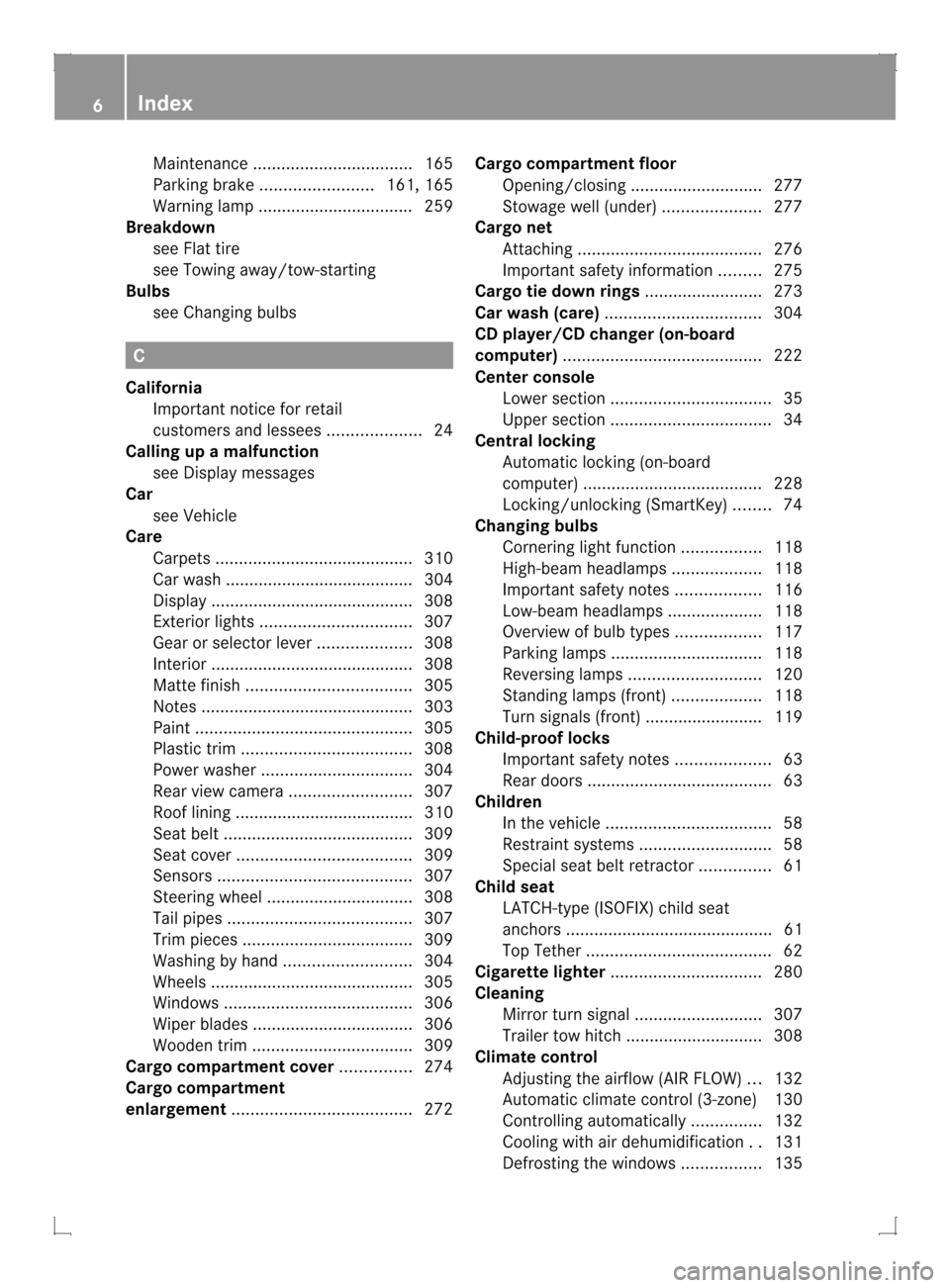
Maintenanc
e.................................. 165
Parking brake ........................ 161, 165
Warning lamp ................................. 259
Breakdown
see Flat tire
see Towing away/tow-starting
Bulbs
see Changing bulbs C
California Important notice for retail
customers and lessees ....................24
Calling up a malfunction
see Display messages
Car
see Vehicle
Care
Carpets .......................................... 310
Car wash ........................................ 304
Display ........................................... 308
Exterior lights ................................ 307
Gea rors electo rlever .................... 308
Interior ........................................... 308
Matte finish ................................... 305
Notes ............................................. 303
Paint .............................................. 305
Plastic trim .................................... 308
Power washer ................................ 304
Rea rview camera .......................... 307
Roof lining ...................................... 310
Seat bel t........................................ 309
Seat cover ..................................... 309
Sensors ......................................... 307
Steering wheel ............................... 308
Tai lpipes ....................................... 307
Trim pieces .................................... 309
Washing by hand ........................... 304
Wheels ........................................... 305
Windows ........................................ 306
Wiper blades .................................. 306
Wooden trim .................................. 309
Cargo compartment cover ...............274
Cargo compartment
enlargement ...................................... 272Cargo compartment floor
Opening/closing ............................ 277
Stowag ewell (under) ..................... 277
Cargo net
Attaching ....................................... 276
Important safety information .........275
Cargo tie down rings .........................273
Car wash (care) ................................. 304
CD player/CD changer (on-board
computer) .......................................... 222
Center console Lowe rsection .................................. 35
Uppe rsection .................................. 34
Central locking
Automatic locking (on-board
computer) ...................................... 228
Locking/unlocking (SmartKey) ........74
Changing bulbs
Cornering light function .................118
High-beam headlamps ...................118
Important safety notes ..................116
Low-beam headlamps ....................118
Overview of bul btypes .................. 117
Parking lamps ................................ 118
Reversing lamps ............................ 120
Standing lamps (front) ...................118
Turn signals (front) ......................... 119
Child-proof locks
Important safety notes ....................63
Rea rdoors ....................................... 63
Children
In the vehicle ................................... 58
Restraint systems ............................ 58
Specia lseat belt retractor ...............61
Child seat
LATCH-type (ISOFIX) child seat
anchors ............................................ 61
Top Tether ....................................... 62
Cigarette lighter ................................ 280
Cleaning Mirro rturn signal ........................... 307
Trailer tow hitch ............................. 308
Climate control
Adjusting the airflow (AIR FLOW) ...132
Automatic climate control (3-zone) 130
Controlling automatically ...............132
Cooling with aird ehumidification..131
Defrosting the windows .................1356
Index
Page 14 of 378
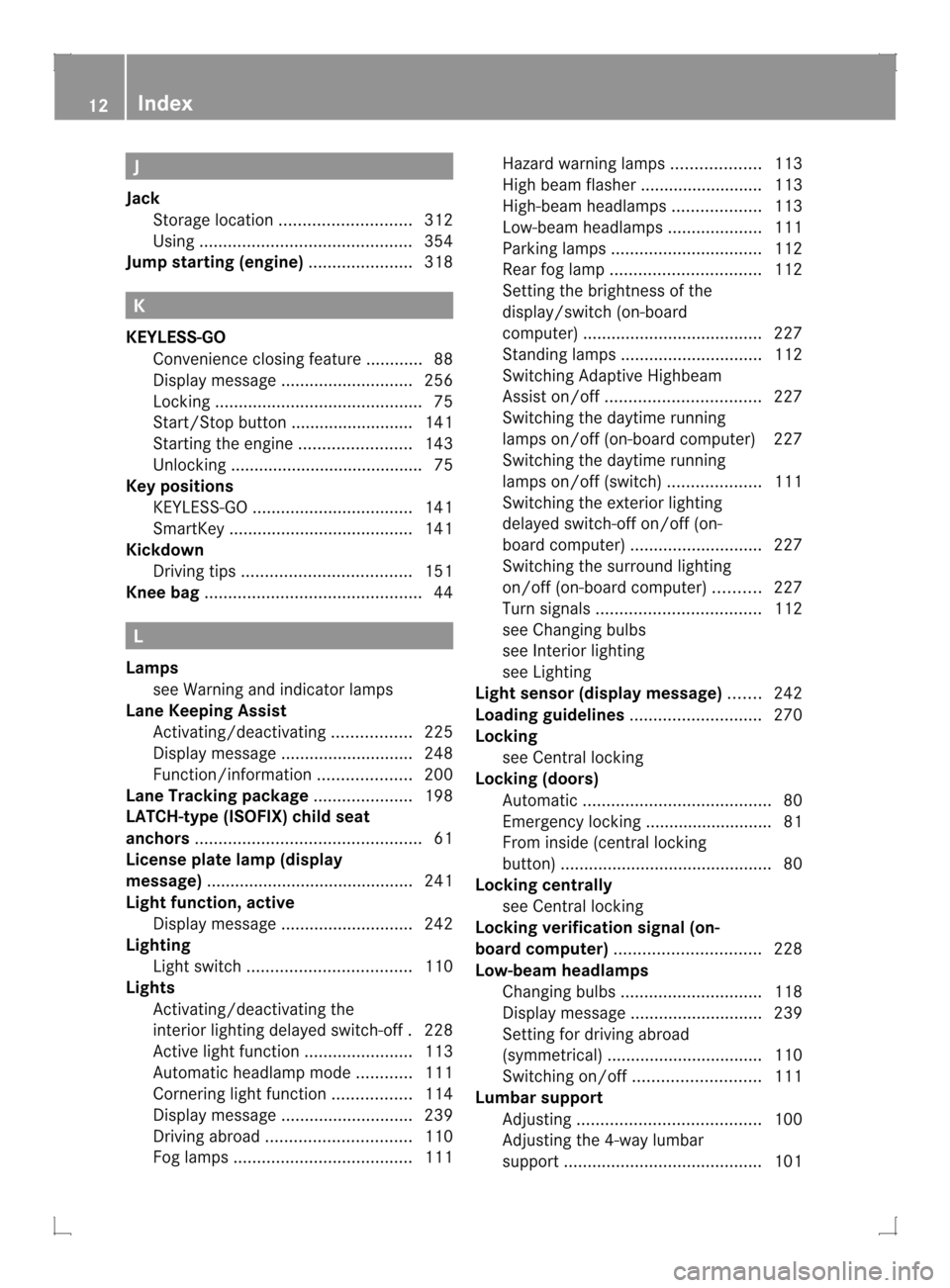
J
Jack Storage location ............................ 312
Using ............................................. 354
Jump starting (engine) ......................318 K
KEYLESS-GO Convenience closing feature ............88
Display message ............................ 256
Locking ............................................ 75
Start/Stop button .......................... 141
Starting the engine ........................143
Unlocking ......................................... 75
Keyp ositions
KEYLESS-GO .................................. 141
SmartKey ....................................... 141
Kickdown
Driving tips .................................... 151
Knee bag .............................................. 44L
Lamps see Warning and indicator lamps
Lane Keeping Assist
Activating/deactivating .................225
Display message ............................ 248
Function/informatio n.................... 200
Lane Tracking package .....................198
LATCH-type (ISOFIX) child seat
anchors ................................................ 61
License plate lamp (display
message) ............................................ 241
Light function ,active
Display message ............................ 242
Lighting
Ligh tswitc h................................... 110
Lights
Activating/deactivating the
interio rlighting delayed switch-off .228
Active light function .......................113
Automatic headlamp mode ............111
Cornering light function .................114
Display message ............................ 239
Driving abroad ............................... 110
Fog lamps ...................................... 111Hazard warning lamps
...................113
High beam flasher .......................... 113
High-beam headlamps ...................113
Low-beam headlamps ....................111
Parking lamps ................................ 112
Rea rfog lamp ................................ 112
Setting the brightness of the
display/switch (on-board
computer) ...................................... 227
Standing lamps .............................. 112
Switching Adaptive Highbeam
Assist on/off ................................. 227
Switching the daytime running
lamps on/off (on-board computer) 227
Switching the daytime running
lamps on/off (switch) ....................111
Switching the exterio rlighting
delayed switch-off on/off (on-
board computer )............................ 227
Switching the surround lighting
on/off (on-board computer) ..........227
Turn signals ................................... 112
see Changing bulbs
see Interior lighting
see Lighting
Light sensor (display message) .......242
Loading guidelines ............................270
Locking see Centra llocking
Locking (doors)
Automatic ........................................ 80
Emergency locking ........................... 81
From inside (central locking
button) ............................................. 80
Locking centrally
see Centra llocking
Locking verification signal (on-
board computer) ............................... 228
Low-beam headlamps Changing bulbs .............................. 118
Display message ............................ 239
Setting for driving abroad
(symmetrical) ................................. 110
Switching on/off ........................... 111
Lumbar support
Adjusting ....................................... 100
Adjusting the 4-way lumbar
support .......................................... 10112
Index
Page 15 of 378
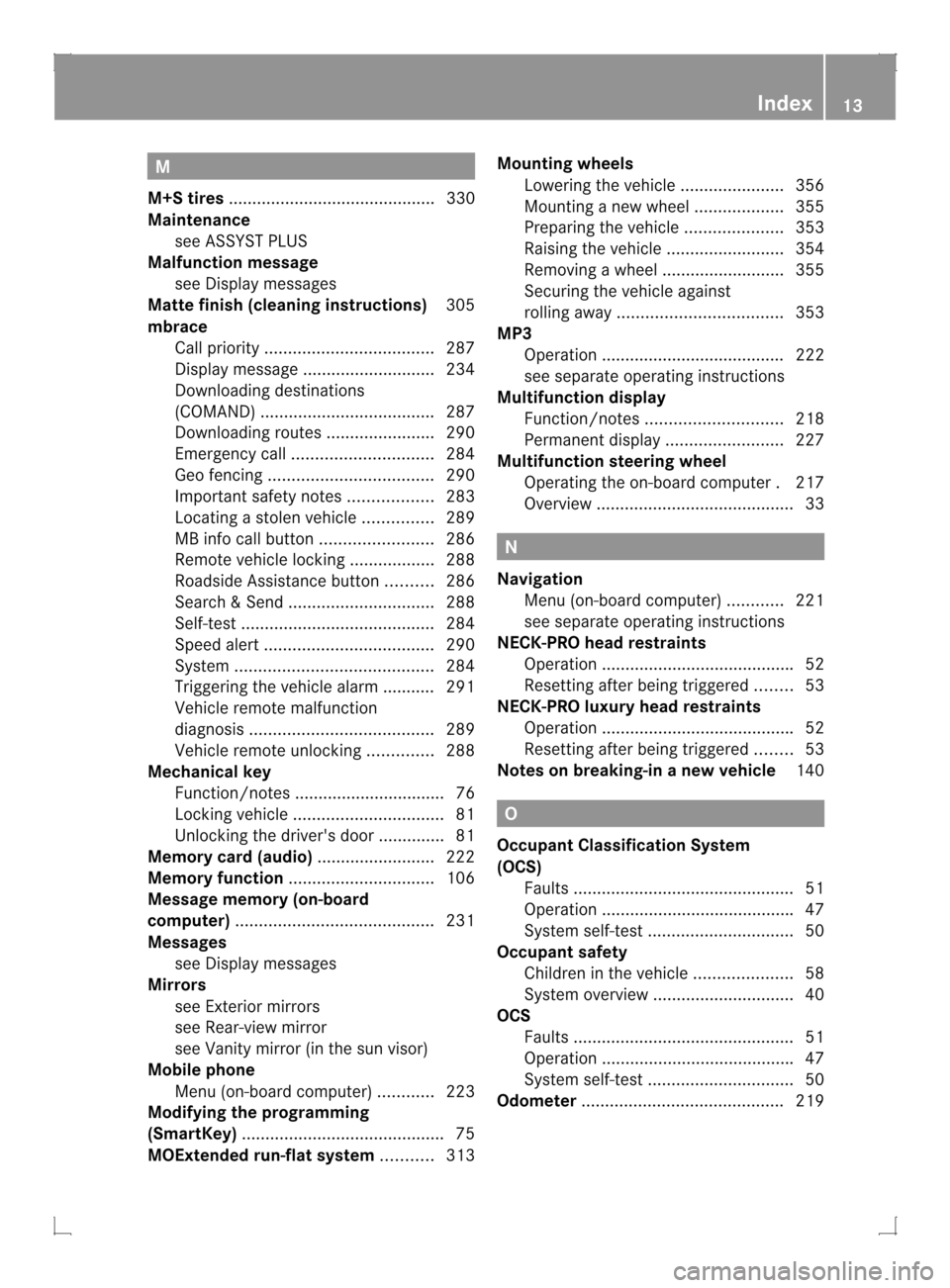
M
M+S tires ............................................ 330
Maintenance see ASSYST PLUS
Malfunction message
see Display messages
Matte finish (cleaning instructions) 305
mbrace Call priority .................................... 287
Display message ............................ 234
Downloading destinations
(COMAND) ..................................... 287
Downloading route s....................... 290
Emergency call .............................. 284
Geo fencing ................................... 290
Important safety notes ..................283
Locating astolen vehicl e............... 289
MB info call button ........................286
Remote vehicle locking ..................288
Roadside Assistance button ..........286
Search &Send ............................... 288
Self-test ......................................... 284
Speed alert .................................... 290
System .......................................... 284
Triggering the vehicle alarm ........... 291
Vehicle remote malfunction
diagnosi s....................................... 289
Vehicle remote unlocking ..............288
Mechanical key
Function/notes ................................ 76
Locking vehicle ................................ 81
Unlocking the driver's door ..............81
Memory card (audio) .........................222
Memory function ............................... 106
Message memory (on-board
computer) .......................................... 231
Messages see Display messages
Mirrors
see Exterior mirrors
see Rear-view mirror
see Vanity mirror (in the sun visor)
Mobile phone
Menu (on-board computer) ............223
Modifying the programming
(SmartKey) ........................................... 75
MOExtended run-flat system ...........313Mounting wheels
Lowering the vehicle ......................356
Mounting anew wheel ................... 355
Preparing the vehicle .....................353
Raising the vehicle .........................354
Removing awheel .......................... 355
Securing the vehicle against
rolling away ................................... 353
MP3
Operation ....................................... 222
see separate operating instructions
Multifunction display
Function/notes ............................. 218
Permanent displa y......................... 227
Multifunction steering wheel
Operating the on-board computer .217
Overview .......................................... 33 N
Navigation Menu (on-board computer) ............221
see separate operating instructions
NECK-PRO head restraints
Operation ........................................ .52
Resetting after being triggered ........53
NECK-PRO luxury head restraints
Operation ........................................ .52
Resetting after being triggered ........53
Notes on breaking-in anew vehicle 140 O
Occupant Classification System
(OCS) Fault s............................................... 51
Operation ........................................ .47
System self-test ............................... 50
Occupant safety
Childre ninthe vehicle ..................... 58
System overview .............................. 40
OCS
Faults ............................................... 51
Operation ........................................ .47
System self-test ............................... 50
Odometer ........................................... 219 Index
13
Page 41 of 378
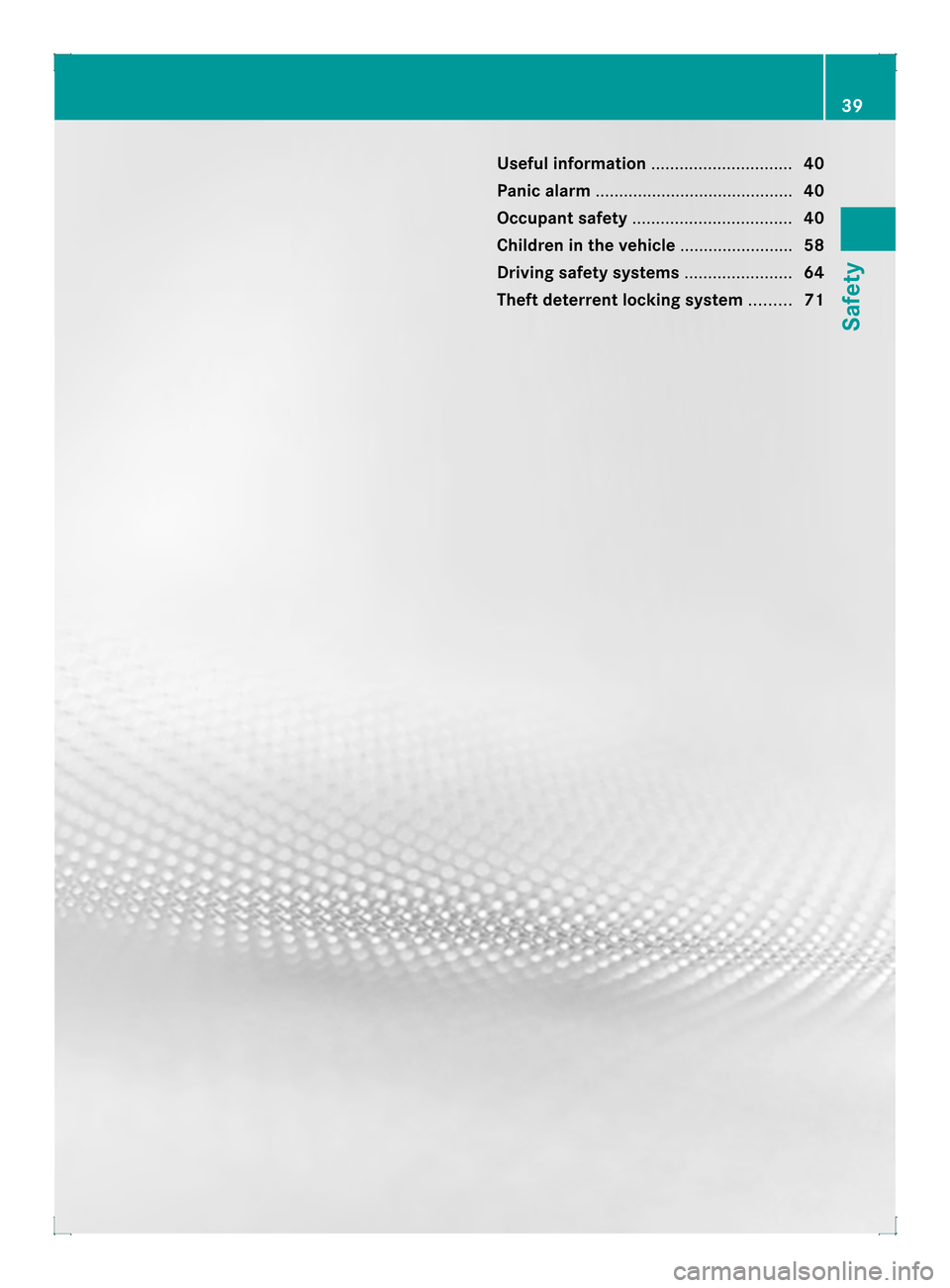
Useful information
..............................40
Panic alarm .......................................... 40
Occupant safety .................................. 40
Children in the vehicle ........................58
Driving safet ysystems ....................... 64
Theft deterrent locking system .........71 39Safety
Page 42 of 378
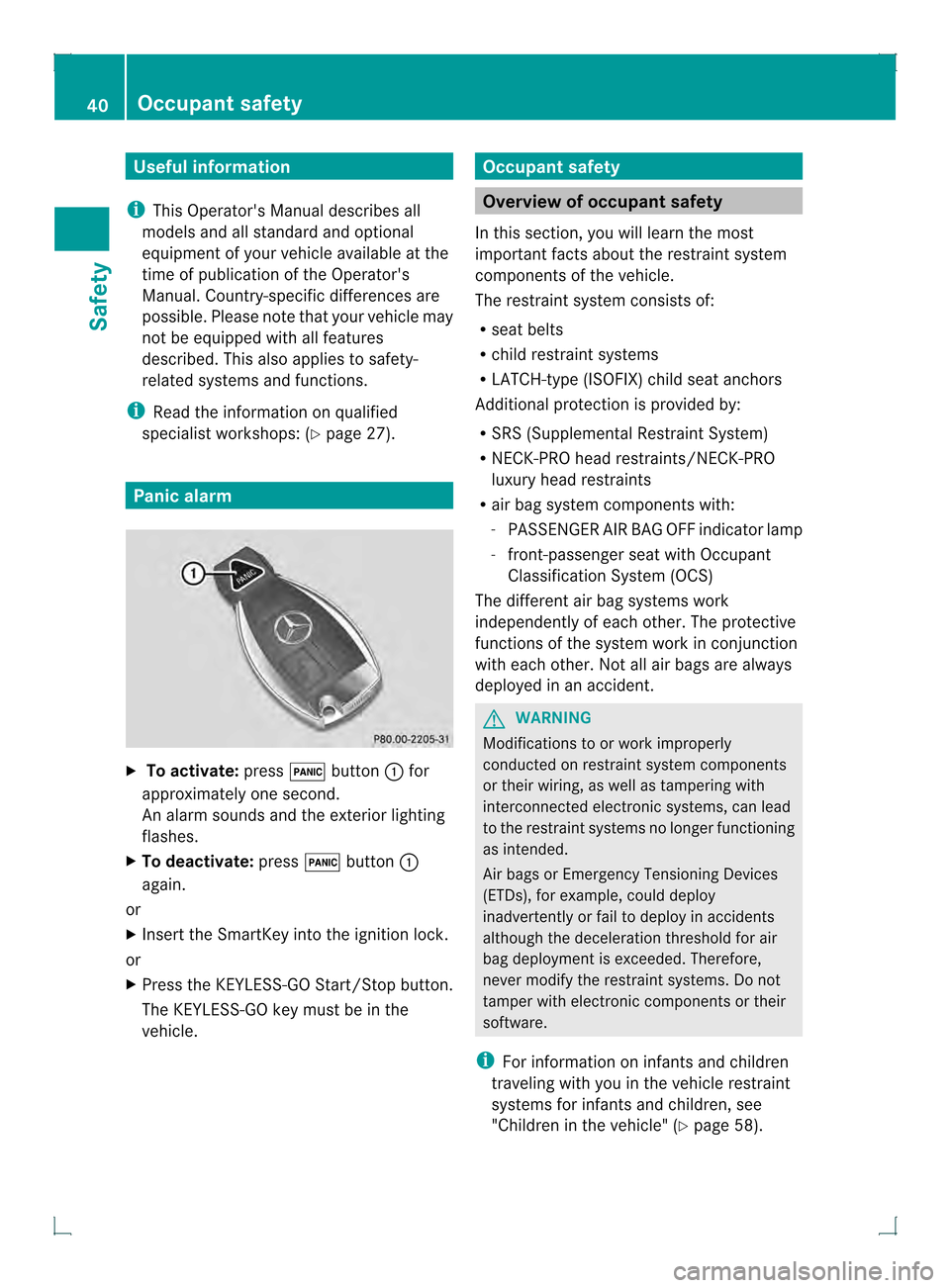
Useful information
i This Operator's Manual describes all
models and all standard and optional
equipment of your vehicle available at the
time of publication of the Operator's
Manual. Country-specific differences are
possible. Please note that your vehicle may
not be equipped with all features
described. This also applies to safety-
related systems and functions.
i Read the information on qualified
specialist workshops: (Y page 27).Panic alarm
X
To activate: press000Dbutton 0002for
approximately one second.
An alarm sounds and the exterior lighting
flashes.
X To deactivate: press000Dbutton 0002
again.
or
X Insert the SmartKey into the ignition lock.
or
X Press the KEYLESS-GO Start/Stop button.
The KEYLESS-GO key must be in the
vehicle. Occupant safety
Overview of occupant safety
In this section, you will learn the most
important facts about the restraint system
components of the vehicle.
The restraint system consists of:
R seat belts
R child restraint systems
R LATCH-type (ISOFIX) child seat anchors
Additional protection is provided by:
R SRS (Supplemental Restrain tSystem)
R NECK-PRO head restraints/NECK-PRO
luxury head restraints
R air bag system components with:
-PASSENGER AI RBAG OFF indicator lamp
- front-passenge rseat with Occupant
Classification System (OCS)
The differen tair bag systems work
independently of each other. The protective
functions of the system work in conjunction
with each other. Not all air bags are always
deployed in an accident. G
WARNING
Modifications to or work improperly
conducted on restraint system components
or their wiring, as well as tampering with
interconnected electronic systems, can lead
to the restraint systems no longer functioning
as intended.
Air bags or Emergency Tensioning Devices
(ETDs), for example, could deploy
inadvertently or fail to deploy in accidents
although the deceleration threshold for air
bag deploymen tis exceeded. Therefore,
never modify the restraint systems. Do not
tamper with electronic components or their
software.
i For information on infants and children
traveling with you in the vehicle restraint
systems for infants and children, see
"Children in the vehicle" (Y page 58).40
Occupant safetySafety
Page 51 of 378
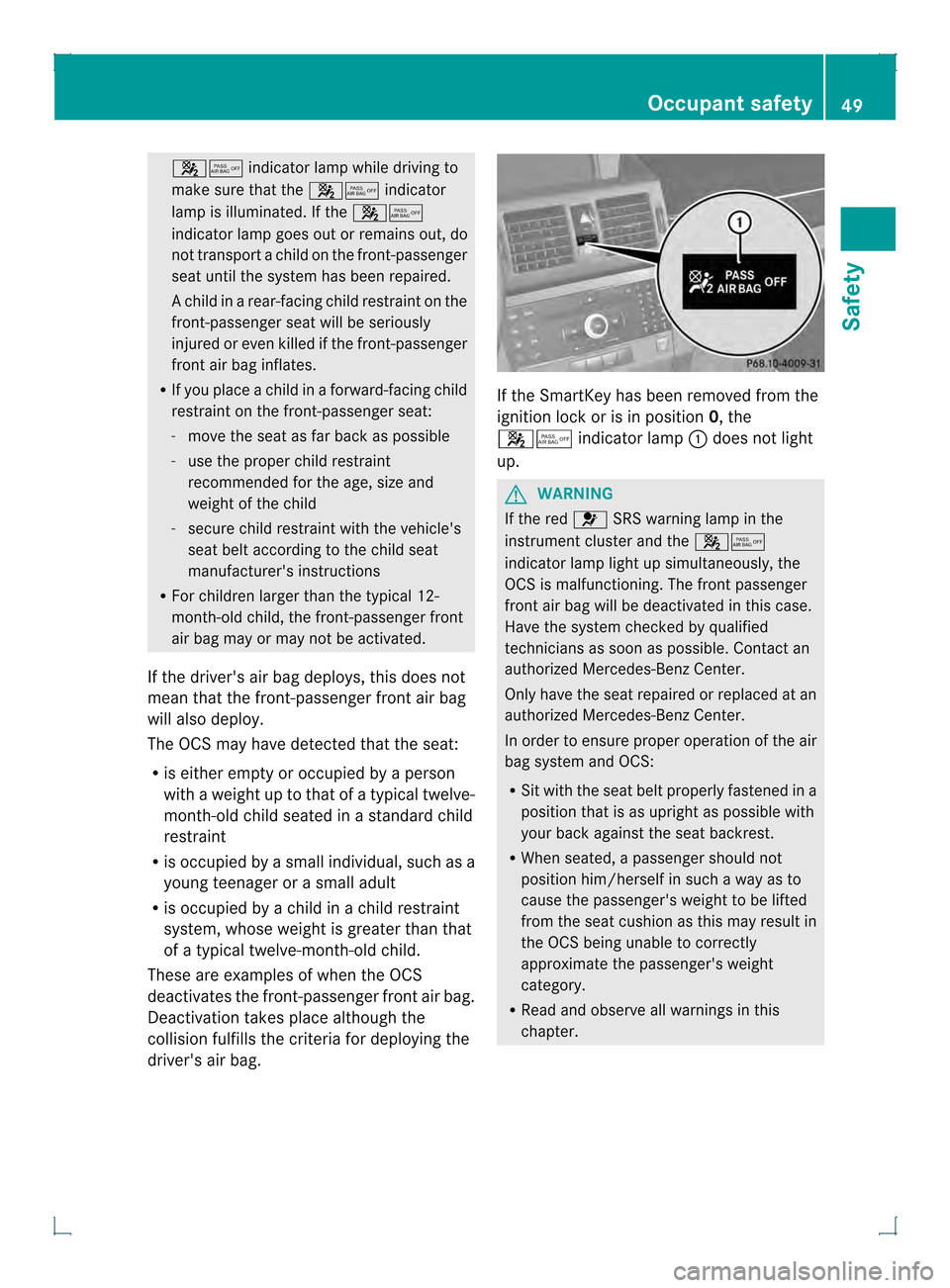
001B001D
indicator lamp while driving to
make sure that the 001B001Dindicator
lamp is illuminated. If the 001B001D
indicator lamp goes out or remains out, do
not transport a child on the front-passenger
seat until the system has been repaired.
Ac hild in a rear-facing child restraint on the
front-passenger seat will be seriously
injured or even killed if the front-passenger
front air bag inflates.
R If you place a child in a forward-facing child
restraint on the front-passenger seat:
-move the seat as far back as possible
- use the proper child restraint
recommended for the age, size and
weight of the child
- secure child restraint with the vehicle's
seat belt according to the child seat
manufacturer's instructions
R For children larger than the typical 12-
month-old child, the front-passenger front
air bag may or may not be activated.
If the driver's air bag deploys, this does not
mean that the front-passenger front air bag
will also deploy.
The OCS may have detected that the seat:
R is either empty or occupied by a person
with a weight up to that of a typical twelve-
month-old child seated in astandard child
restraint
R is occupied by a small individual, such as a
young teenager or a small adult
R is occupied by a child in a child restraint
system, whose weight is greate rthan that
of a typical twelve-month-old child.
These are examples of when the OCS
deactivates the front-passenger front air bag.
Deactivation takes place although the
collision fulfills the criteria for deploying the
driver's air bag. If the SmartKey has been removed from the
ignition lock or is in position
0, the
001B001D indicator lamp 0002does not light
up. G
WARNING
If the red 0020SRS warning lamp in the
instrument cluster and the 001B001D
indicator lamp light up simultaneously, the
OCS is malfunctioning. The front passenger
front air bag will be deactivated in this case.
Have the system checked by qualified
technicians as soon as possible. Contact an
authorized Mercedes-Ben zCenter.
Only have the seat repaired or replaced at an
authorized Mercedes-Benz Center.
In order to ensure proper operation of the air
bag system and OCS:
R Sit with the seat belt properly fastened in a
position that is as upright as possible with
your back against the seat backrest.
R When seated, a passenger should not
position him/herself in such a way as to
cause the passenger's weight to be lifted
from the seat cushion as this may result in
the OCS being unable to correctly
approximate the passenger's weight
category.
R Read and observe all warnings in this
chapter. Occupant safety
49Safety Z
Page 52 of 378
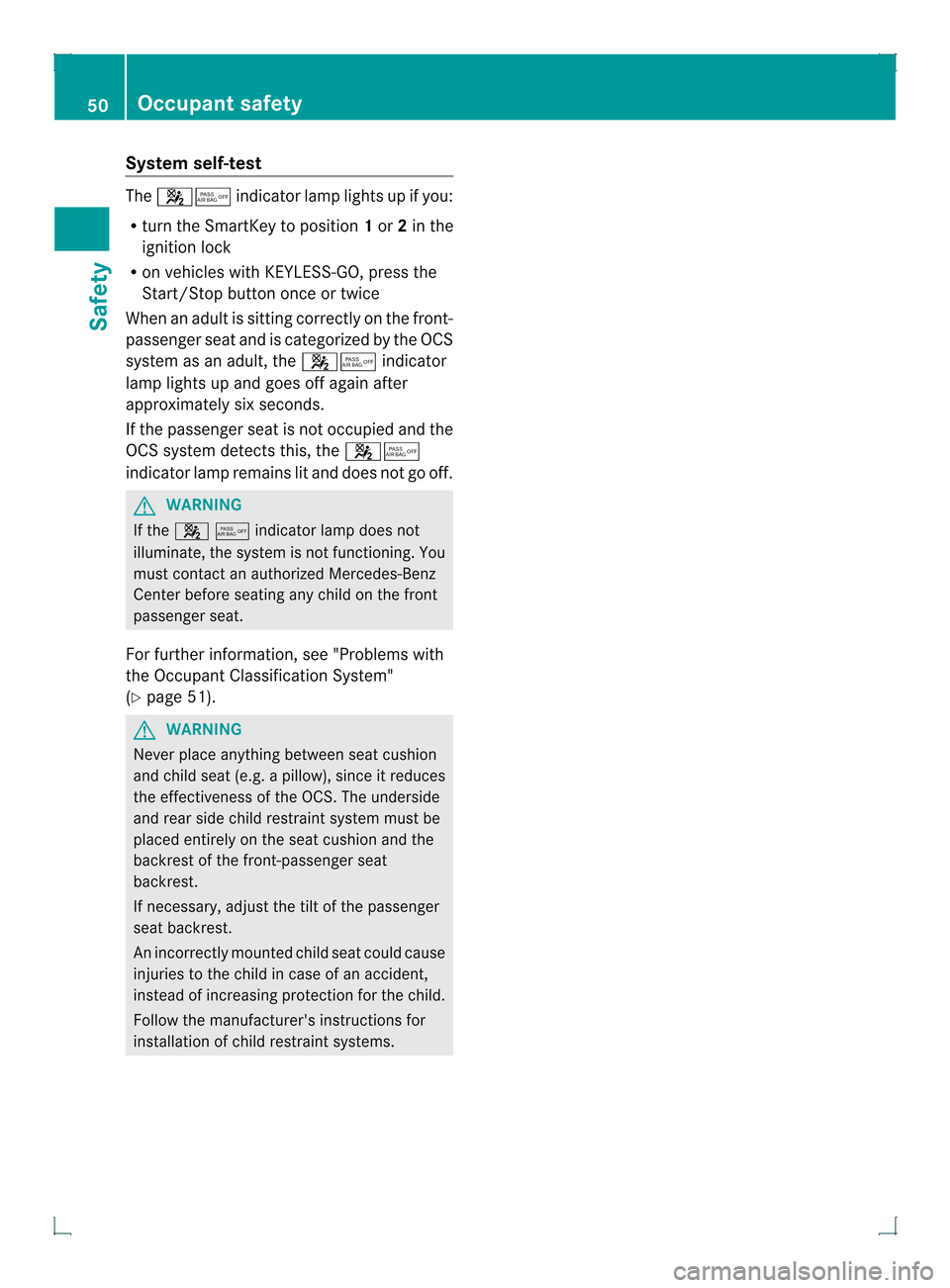
System self-test
The
001B001D indicator lamp lights up if you:
R turn the SmartKey to position 1or 2in the
ignition lock
R on vehicles with KEYLESS-GO, press the
Start/Stop button once or twice
When an adulti s sitting correctly on the front-
passenger seat and is categorized by the OCS
system as an adult, the 001B001Dindicator
lamp lights up and goes off againa fter
approximately six seconds.
If the passenger sea tis not occupied and the
OCS system detects this, the 001B001D
indicator lamp remains lit and does not go off. G
WARNING
If the 001B001Dindicator lamp does not
illuminate, the system is not functioning. You
must contact an authorized Mercedes-Benz
Center before seating any child on the front
passenger seat.
For further information, see "Problems with
the Occupant Classification System"
(Y page 51). G
WARNING
Never place anything betwee nseat cushion
and child seat (e.g. a pillow), since it reduces
the effectiveness of the OCS. The underside
and rear side child restraint system must be
placed entirely on the seat cushion and the
backrest of the front-passenger seat
backrest.
If necessary, adjust the tilt of the passenger
seat backrest.
An incorrectly mounted child seat could cause
injuries to the child in case of an accident,
instead of increasing protection for the child.
Follow the manufacturer's instructions for
installation of child restraint systems. 50
Occupant safetySafety
Page 58 of 378

Never attempt to make modifications to seat
belts. This could impairt
he effectiveness of
the seat belts.
Fastening seat belts G
WARNING
According to accident statistics, children are
safer when properly restrained on the rear
seats than on the front-passenger seat. Thus,
we strongly recommend that children be
placed in the rear seat whenever possible.
Regardless of seating position, children 12
years old and under must be seated and
properly secured in an appropriately sized
child restraint system or booster seat
recommended for the size and weight of the
child. For additional information, see the
"Children in the vehicle" section.
Ac hild's risk of serious or fatal injuries is
significantly increased if the child restraints
are not properly secured in the vehicle and/
or the child is not properly secured in the child
restraint. X
Adjust the seat and move the backrest to
an almost vertical position (Y page 96).
X Pull the seat belt smoothly through belt
sash guide 0002.
X Without twisting it, guide the shoulder
section of the seat belt across the middle of your shoulder and the lap section across
your pelvis.
X Engage belt tongue 0003in buckle 0021.
X If necessary, adjust the seat belt to the
appropriate height (Y page 56).
X If necessary, pull upwards on the shoulder
section of the seat belt to tighten the belt
across your body.
All seat belts except the driver's seat belt are
equipped with a special seat belt retractor to
securely fasten child restraint systems in the
vehicle. For further information on special
seat belt retractors, see (Y page 61).
For more information about releasing the seat
belt with release button 0020, see "Releasing
seat belts" (Y page 57).
Seat belt adjustment The seat-belt adjustment function adjusts the
driver's and front-passenger seat belt to the
upper body of the occupants.
The belt strap is tightened slightly when:
R
you engage the belt tongue in the belt
buckle and you then turn the SmartKey to
position 2in the ignition lock.
The seat-belt adjustment will apply a
retraction force if any slack is detected
between the occupant and the seat belt. Do
not hold on to the seat belt tightly while it is
adjusting. You can switch the seat-belt
adjustment on and off in the on-board
computer (Y page 229).
The seat-belt adjustment is an integral part of
the PRE-SAFE ®
convenience function. More
information about PRE-SAFE ®
can be found
in the "PRE-SAFE ®
(anticipatory occupant
protection system)" section (Y page 52).
Belt height adjustment You can adjust the seat belt height on the
driver's seat and the front-passenger seat. 56
Occupant safetySafety
Page 60 of 378
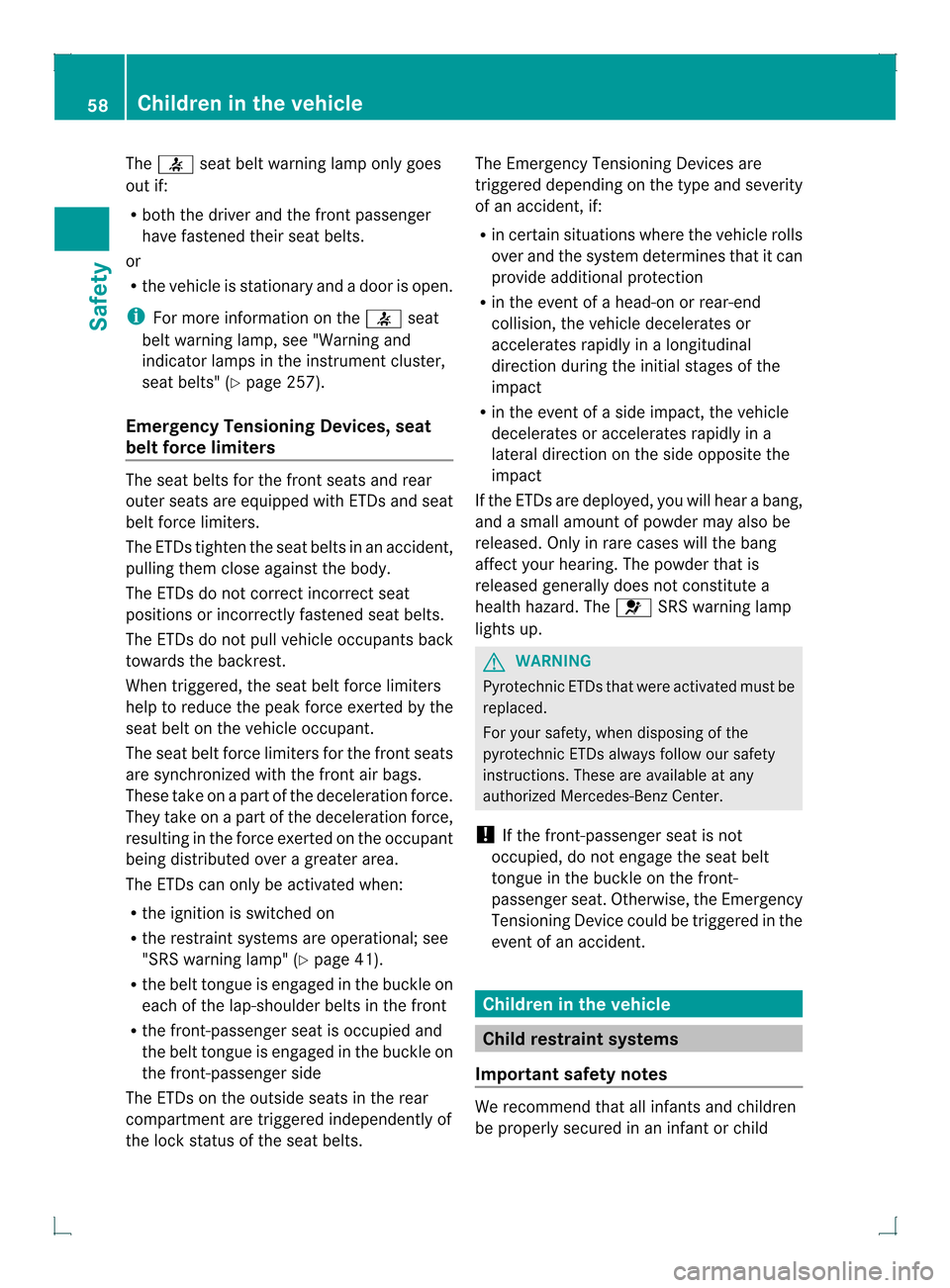
The
0021 seat belt warning lamp only goes
out if:
R both the driver and the frontp assenger
have fastened their seat belts.
or
R the vehicle is stationary and a door is open.
i For more information on the 0021seat
belt warning lamp, see "Warning and
indicator lamps in the instrument cluster,
seat belts" ( Ypage 257).
Emergency Tensioning Devices, seat
belt force limiters The seat belts for the fron
tseats and rear
outer seats are equipped with ETDs and seat
belt force limiters.
The ETDs tighten the seat belts in an accident,
pulling them close against the body.
The ETDs do not correct incorrect seat
positions or incorrectly fastened seat belts.
The ETDs do not pull vehicle occupants back
towards the backrest.
When triggered, the seat belt force limiters
help to reduce the peak force exerted by the
seat belt on the vehicle occupant.
The seat belt force limiters for the fron tseats
are synchronized with the fron tair bags.
These take on a part of the deceleration force.
They take on a part of the deceleration force,
resulting in the force exerted on the occupant
being distributed over a greater area.
The ETDs can only be activated when:
R the ignition is switched on
R the restraint systems are operational; see
"SRS warning lamp" (Y page 41).
R the belt tongue is engaged in the buckle on
each of the lap-shoulder belts in the front
R the front-passenger seat is occupied and
the belt tongue is engaged in the buckle on
the front-passenger side
The ETDs on the outside seats in the rear
compartmen tare triggered independently of
the lock status of the seat belts. The Emergency Tensioning Devices are
triggered depending on the type and severity
of an accident, if:
R
in certain situations where the vehicle rolls
over and the system determines that it can
provide additional protection
R in the event of a head-on or rear-end
collision, the vehicle decelerates or
accelerates rapidly in a longitudinal
direction during the initia lstages of the
impact
R in the event of a side impact, the vehicle
decelerates or accelerates rapidly in a
lateral directio nonthe side opposite the
impact
If the ETDs are deployed, you will hear a bang,
and a small amount of powder may also be
released. Only in rare cases will the bang
affect your hearing. The powder that is
released generally does not constitute a
health hazard. The 0020SRS warning lamp
lights up. G
WARNING
Pyrotechnic ETDs that were activated must be
replaced.
For your safety, when disposing of the
pyrotechnic ETDs always follow our safety
instructions. These are available at any
authorized Mercedes-Ben zCenter.
! If the front-passenger seat is not
occupied, do not engage the seat belt
tongue in the buckle on the front-
passenger seat. Otherwise, the Emergency
Tensioning Device could be triggered in the
event of an accident. Children in the vehicle
Child restraint systems
Important safety notes We recommend that all infants and children
be properly secured in an infan
torchild 58
Children in the vehicleSafety
Page 62 of 378
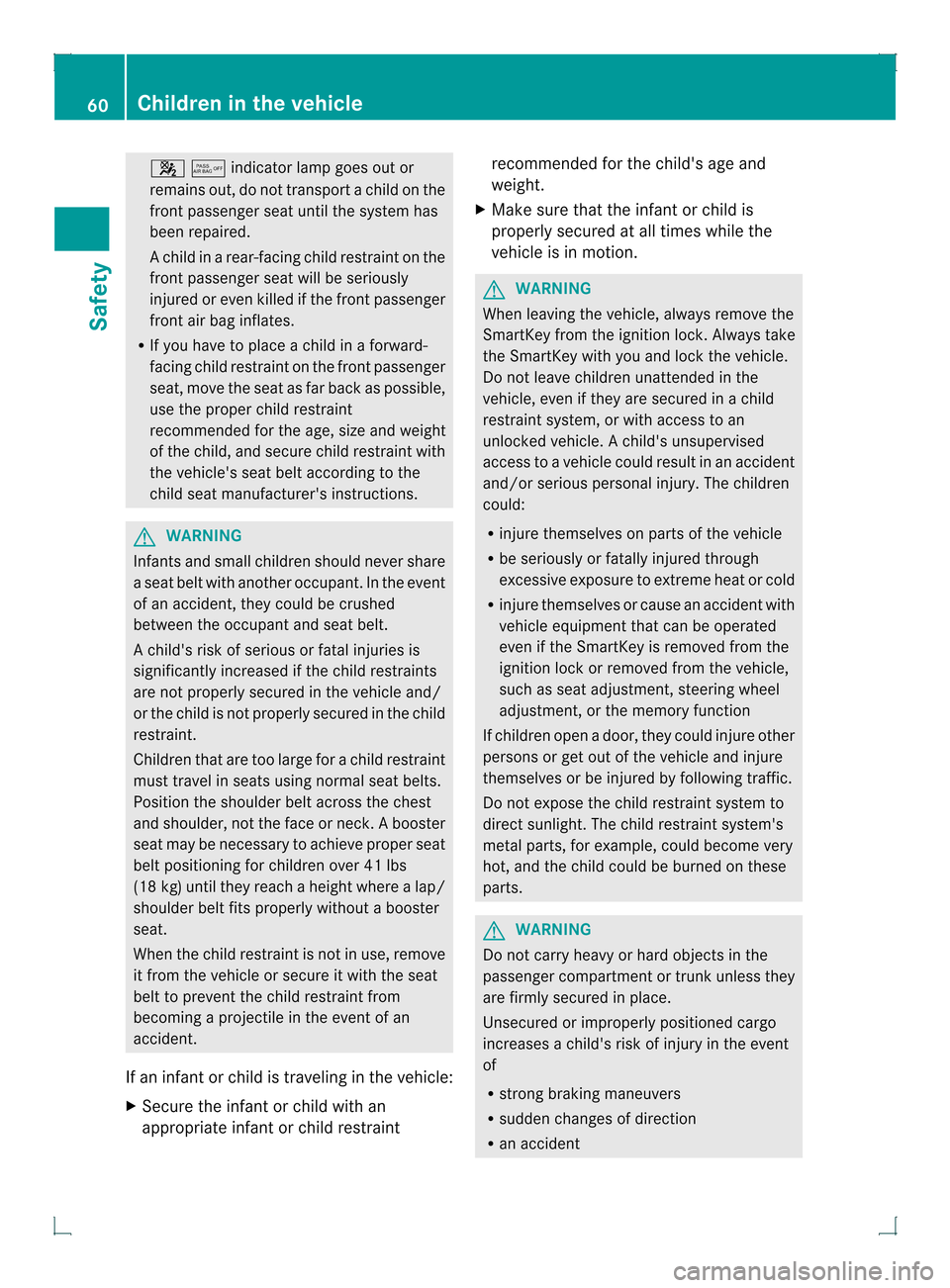
001B001Dindicator lamp goes out or
remains out, do not transport a child on the
front passenger seat until the system has
been repaired.
Ac
hild in a rear-facing child restraint on the
front passenger seat will be seriously
injured or even killed if the front passenger
front air bag inflates.
R If you have to place a child in a forward-
facing child restraint on the front passenger
seat, move the seat as far back as possible,
use the proper child restraint
recommended for the age, size and weight
of the child, and secure child restraint with
the vehicle's seat belt according to the
child seat manufacturer's instructions. G
WARNING
Infants and small children should never share
a seat belt with another occupant. In the event
of an accident, they could be crushed
between the occupant and seat belt.
Ac hild's risk of serious or fatal injuries is
significantly increased if the child restraints
are not properly secured in the vehicle and/
or the child is not properly secured in the child
restraint.
Children that are too large for a child restraint
must travel in seats using normal seat belts.
Position the shoulder belt across the chest
and shoulder, not the face or neck.Ab ooster
seat may be necessary to achieve proper seat
belt positioning for children over 41 lbs
(18 kg) until they reach a height where alap/
shoulder belt fits properly without a booster
seat.
When the child restraint is no tinuse, remove
it from the vehicle or secure it with the seat
belt to prevent the child restraint from
becoming a projectile in the event of an
accident.
If an infant or child is traveling in the vehicle:
X Secure the infant or child with an
appropriate infant or child restraint recommended for the child's age and
weight.
X Make sure that the infant or child is
properly secured at all times while the
vehicle is in motion. G
WARNING
When leaving the vehicle, always remove the
SmartKey from the ignition lock. Always take
the SmartKey with you and lock the vehicle.
Do not leave children unattended in the
vehicle, even if they are secured in a child
restraint system, or with access to an
unlocked vehicle. Achild's unsupervised
access to a vehicle could result in an accident
and/or serious personal injury. The children
could:
R injure themselves on parts of the vehicle
R be seriously or fatally injured through
excessive exposure to extreme heat or cold
R injure themselves or cause an accident with
vehicle equipment that can be operated
even if the SmartKey is removed from the
ignition lock or removed from the vehicle,
such as seat adjustment, steering wheel
adjustment, or the memory function
If children open a door, they could injure other
persons or get out of the vehicle and injure
themselves or be injured by following traffic.
Do not expose the child restraint system to
direct sunlight. The child restraint system's
metal parts, for example, could become very
hot, and the child could be burned on these
parts. G
WARNING
Do not carry heavy or hard objects in the
passenger compartmentort runk unless they
are firmly secured in place.
Unsecured or improperly positioned cargo
increases a child's risk of injury in the event
of
R strong braking maneuvers
R sudden changes of direction
R an accident 60
Children in the vehicleSafety